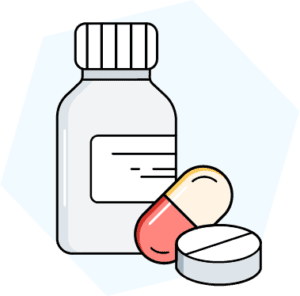Prescription insurance helps consumers pay for the medications they need to improve or maintain their health. It’s a standard benefit in many health insurance plan types, including employer-sponsored plans, Marketplace plans, and Medicaid, and as an optional benefit in Medicare.
This guide explains how prescription coverage insurance works, including what it covers, what it does not, and how much it costs.
Table of Contents
- Insurance Can Help Keep Medication Affordable
- How Medical Prescription Coverage Works
- Understand Your Plan’s Drug Tiers and Pricing
- The Costs of Prescription Coverage Insurance
- Health Insurance Types and How It Affects Your Coverages
- Advantages and Drawbacks to Prescription Coverage
- Medicare Part D: Another Prescription Insurance Option
- How to Use Your Prescription Coverage and Keep Costs Down
- Putting It All Together
- FAQ
Insurance Can Help Keep Medication Affordable
Medications are widely prescribed to reduce symptoms of illnesses, keep chronic conditions under control, and maintain overall health. Nearly half of Americans (48.6%) take at least one prescription drug, while nearly a quarter (24%) take three or more.
Unfortunately, costs are a barrier for many consumers. More than a third of Americans (37%) say they’ve left a prescription unfilled because they couldn’t afford the drug. By helping cover these costs, prescription drug coverage makes it easier for consumers to pay for the drugs they need.
How Medical Prescription Coverage Works

Health insurance plans that offer prescription drug benefits help pay for specific medications, which can vary from plan to plan. A plan’s list of covered drugs is known as its formulary. Depending on the plan, this coverage may start before or after the deductible.
Formularies do not include every drug on the market, but they include a range of medications in different categories and classes. This helps ensure plan members can access appropriate drugs for their health conditions. Drugs that are not listed on the formulary are not covered.
Prescription drug coverage is generally subject to a deductible. A plan’s deductible is the amount of money consumers pay out of pocket for covered services before their health plan starts helping with costs. The amount ranges from zero to $7,500 or more. However, some plans cover prescription drugs before members reach their deductible.
Some health insurance plans have a separate deductible for prescription drugs, which is generally lower than the deductible for health services. Only expenses for covered prescription drugs count toward this deductible.
What Does Prescription Insurance Cover?
Prescription drug insurance covers a variety of medications that plan members need. The specific drugs can vary from plan to plan but include:
- Brand-name drugs: These prescription drugs are marketed under a trademark-protected name and made by a single manufacturer.
- Generic drugs: These unbranded drugs are copies of brand-name medications and may be produced by several manufacturers.
- Specialty drugs: These higher-cost drugs are used to treat complex or rare diseases and may have special storage or handling requirements.
This coverage is often provided within a network of pharmacies. In some plans, coverage is limited to in-network pharmacies. In others, consumers can fill prescriptions at out-of-network pharmacies but at a higher cost.
What Does Prescription Insurance Not Cover?
Prescription drug benefit exclusions vary from plan to plan. Some common medication expenses that are not covered include:
- Non-formulary medications: Each plan covers a list of drugs, known as the formulary. Drugs that are not listed on the formulary are not covered unless the plan member gets the insurer to make an exception.
- Over-the-counter medications: Health insurance plans generally do not cover nonprescription drugs.
- Drugs without prior authorization: In plans with prior authorization requirements, members are required to get approval from the plan before a drug is covered.
- Higher-than-normal doses: Plans set quantity limits for covered drugs based on Federal Drug Administration (FDA) and manufacturer guidelines.
- Out-of-network pharmacies: In plans with no out-of-network coverage, people who fill prescriptions outside of the network pay the full cost.
Your Options If Your Prescribed Drug Is Not Covered By Insurance
Sometimes, consumers take specific drugs that their health insurance plan does not cover. Some choose to pay for these medications out of pocket, but there are also other options to consider, including:
- Asking your doctor about switching drugs: Another drug on the plan’s formulary may be suitable for your health needs.
- Submitting an exception request: Insurers may agree to cover a drug that’s not on the formulary when medically necessary.
- Contacting the drug manufacturer: Many manufacturers offer patient assistance programs and/or drug coupons that reduce the cost of their products.
- Talking to your pharmacist: Some pharmacies offer programs that help offset the cost of prescriptions.
Understand Your Plan’s Drug Tiers and Pricing

Health insurance plans typically divide their medication formularies into three to six tiers of coverage. These tiers determine how much plan members pay for their prescriptions. Drugs in lower tiers tend to have lower cost-sharing requirements, while drugs in higher tiers have higher out-of-pocket costs.
Each plan structures its own formulary, so the placement of specific drugs varies from plan to plan. Generally, drugs in the lower tiers are low-cost generic drugs, while name-brand or specialty medications are in the higher tiers. Check your plan’s drug list to determine which tier your medications are on.
How Much Does Medication Cost With Prescription Insurance?
The prices consumers pay for their medications vary depending on their location, the pharmacy they use, whether they choose a name-brand or generic version of the drug, and their health insurance plan.
The chart below displays typical retail prices for common drugs and how much they generally cost with insurance.
Drug | Typical Retail Price (Generics) | Typical Cost With Insurance |
|---|---|---|
Epinephrine auto-injectors for severe allergies | $350 to $650 for a package of 2 auto-injectors | $0 to $25 copay |
Steroid inhalers for asthma | $300 to $350 per inhaler | $0 to $40 copay |
Cholesterol-lowering medication | $30 to $130 for a 1-month supply | $0 to $25 copay |
Short-acting insulin for diabetes | $100 to $150 per vial | $25 to $60 copay |
Drugs for moderate to severe pain | $50 to $80 for 60 tablets | $0 to $25 copay |
The Costs of Prescription Coverage Insurance
Consumers who have a health insurance plan with prescription drug benefits pay deductibles, copayments, and coinsurance for their medications. Plans have annual out-of-pocket limits that cap these costs.
The deductible is the amount of money consumers are required to pay out of pocket before their plan begins to pay. Some plans have a combined deductible for health and drug coverage, while others have a separate deductible for drugs.
After meeting their plan’s deductible, members pay a share of the cost of covered medications. There are two types of cost-sharing:
- Copayments: These are a set dollar amount for each prescription filled. Insurers generally charge lower copayments for generic drugs and higher copayments for name-brand medications.
- Coinsurance: This is a percentage of the cost of each prescription filled. Insurers generally use coinsurance for pricier drugs, such as non-preferred brand medications or specialty drugs.
Health insurance plans typically have yearly caps on members’ out-of-pocket spending. Spending on covered medications counts toward this limit. When a member reaches this cap, their plan pays the full cost of covered services for the rest of the year.
Health Insurance Types and How It Affects Your Coverages
The majority of health insurance types offer coverage for prescription drugs, but each type of insurance handles this coverage differently. The type of health insurance a consumer chooses determines whether or not they have drug coverage and, if so, how much they pay for their medications.
Common types of health insurance coverage include Affordable Care Act (ACA) plans, non-ACA-compliant plans, and Medicaid or Children’s Health Insurance Program (CHIP) plans. Read on for details about how prescription drug coverage works in these plan types.
Affordable Care Act (ACA) Plans
The Affordable Care Act (ACA), commonly known as Obamacare, is a 2010 law designed to make health insurance coverage more fair and affordable. It introduced new rights and protections that help consumers access the drugs they need.
ACA-compliant plans, like those sold through the Marketplace or offered by employers, are required to provide coverage for prescription drugs. They’re not allowed to set yearly or lifetime limits on these benefits or to cancel a person’s coverage just because they take expensive medications.
High Deductible Health Plans (HDHP)
Some ACA-compliant plans are high-deductible health plans, which means they have higher deductibles than traditional plans. HDHPs are individual plans with annual deductibles of $1,500 or more or family plans with deductibles of $3,000 or more.
These plans offer coverage for prescription drugs. However, members are responsible for the full cost of their medications until they reach their deductible. These high deductibles could make it harder to access medications for people who take more expensive drugs.
Health Savings Account (HSA) Plans
Health Savings Accounts are tax-advantaged savings accounts that work with high-deductible health plans. They help plan members pay for medical and prescription drug costs before they reach their deductible.
Plan members contribute pre-tax dollars to their HSAs. Withdrawals are not taxed if they’re used to pay for qualified medical expenses, including prescription medications. Unspent funds roll over yearly, allowing members to save up for future expenses.
Flexible Spending Account (FSA) Plans
Flexible Spending Accounts, or Flexible Spending Arrangements, are employer-sponsored accounts that help consumers save for health and drug expenses. They’re not limited to consumers with HDHPs.
Like HSAs, FSAs are funded with pre-tax income. Plan members pay for health care costs, such as insurance deductibles or prescription drugs, then submit a request for reimbursement. Unspent FSA funds are forfeited at the end of the year unless the plan offers a carryover or grace period.
Non-ACA-compliant Plans
Some types of health plans are not required to follow the ACA’s consumer protection rules. Non-ACA-compliant plans include short-term plans, which offer coverage for less than a year, and fixed indemnity plans, which pay set amounts for various health services.
Some non-ACA-compliant plans offer coverage for prescription drugs, but this is not required. Plans also are not required to cover costs related to pre-existing conditions. For example, if a consumer has asthma, their plan can refuse to cover the costs of asthma medications.
Medicaid and CHIP
Medicaid is a government program that provides free or low-cost health coverage to eligible low-income people. CHIP covers children in families that earn too much to enroll in Medicaid. Both Medicaid and CHIP cover prescription drugs.
Each state runs its own Medicaid and CHIP program, so the details of drug coverage vary based on location. Generally, states maintain a list of preferred drugs, and medications that are not on this list require prior authorization. Some states limit the number of prescriptions enrollees can get each month.
Advantages and Drawbacks to Prescription Coverage
Prescription coverage insurance offers many potential advantages for consumers, which is why it’s included as a standard benefit in the majority of health plans. However, there are also some potential disadvantages. Understanding the pros and cons of prescription drug benefits can help you make more informed coverage decisions.
- Lower drug costs
- Greater medicaiton adherence
- Improved health
- Capped drug spending
- Formulary exlcusions
- Prior authorization requirements
- Step therapy rules
- Formulary updates
Advantages
- Lower drug costs: Health plans help cover the costs of medically necessary drugs and make routine prescriptions more affordable for consumers.
- Greater medication adherence: People with health insurance are much more likely to take their medications as prescribed compared to people without this coverage.
- Improved health: Taking medications as directed is linked to better health outcomes, especially for people with chronic conditions.
- Capped drug spending: Health plans with annual out-of-pocket maximums help shield consumers from the high costs of specialty medications, such as those used to treat cancer or autoimmune conditions.
Drawbacks
- Formulary exclusions: If a plan member takes a drug their plan does not cover, they must pay for the medication out of pocket unless they get an exception.
- Prior authorization requirements: This means consumers need to get approval from their health plan before filling prescriptions for certain drugs.
- Step therapy rules: Step therapy is a requirement to try lower-cost alternatives before the insurer covers a more expensive medication.
- Formulary updates: When plans remove drugs from their formularies or move drugs to higher tiers, consumers who take those drugs face higher costs.
Medicare Part D: Another Prescription Insurance Option
Medicare, the federal health insurance program for older adults and people with disabilities, handles drug coverage differently than other plan types. It does not automatically cover prescription drugs. Instead, beneficiaries who want drug coverage enroll in a Part D drug plan.
Like other prescription coverage insurance options, Medicare Part D plans have their own formularies and generally divide covered drugs into tiers. Part D formularies are required to cover at least two drugs in each commonly prescribed category and class.
Eligibility Criteria
This optional prescription drug coverage is available to anyone with Medicare. Beneficiaries are eligible to join a Part D plan if:
- You are enrolled in Medicare Part A and/or Part B
- You are U.S. citizens or lawfully present in the United States
- You live within the plan’s service area
Should You Get Medicare Part D?
Medicare Part D offers potential advantages over other sources of drug coverage. These private plans are required to cover all drugs in certain protected categories, including anticancer drugs, to help ensure members with complex health needs can access their prescriptions. They also can’t charge members more than $35 per month for covered insulin.
However, there are also some disadvantages to consider, especially for consumers with other drug coverage. Some employer or union plans disenroll members who sign up for Part D drug coverage, which can lead to dependents losing coverage. Ask your benefits administrator for more information.
The Medicare Part D “Donut Hole”

Medicare Part D drug plans have a coverage gap phase known as a “donut hole.” During this phase, plan members generally pay more for their covered prescription drugs.
As of 2023, plan members reach the coverage gap when they and their plan have spent $4,660 on covered drugs. Generally, they pay 25% of the cost of their name-brand and generic drugs instead of the plan’s standard copays.
The coverage gap is temporary and ends when plan members reach $7,400 in out-of-pocket drug spending. At that point, Medicare’s catastrophic coverage kicks in, and beneficiaries are responsible for small copays.
How to Get Medicare Part D
Medicare-approved private insurance companies sell Part D drug plans. This coverage comes in two forms: Standalone Medicare drug plans and Medicare Advantage Plans with drug coverage.
Standalone drug plans are designed to complement Original Medicare, the traditional program run by the government. They’re also compatible with certain Medicare Advantage Plans that do not include drug coverage, such as Medical Savings Account Plans. The majority of Medicare Advantage Plans include Part D drug coverage, as well as Part A and Part B. However, some do not, so check the plan details before enrolling.
How to Use Your Prescription Coverage and Keep Costs Down
Enrolling in medical prescription coverage helps make medications more affordable, but once you have this coverage, there are ways to lower costs even further. Understanding what medications your plan covers and the rules for filling prescriptions can help you maximize your coverage.
1. Check Your Plan’s Coverages
Review your plan’s Summary of Benefits and Coverage for details about how it covers prescription drugs. This document explains the plan’s deductibles and out-of-pocket limits, as well as the coinsurance or copayment amounts for medications.
To learn which medications the plan covers, check the formulary. This document lists every drug the plan covers, including details about approved dosing and tier placement. It also lists coverage requirements and quantity limits, if applicable.
2. Ask Your Doctor If Substitutions Can Be Made
Some consumers take prescription medications that are not covered by their plans or are covered on a higher tier with high cost-sharing requirements. To keep costs down, ask your doctor if any lower-cost alternatives might work just as well.
Doctors are not necessarily familiar with health plan formularies and costs, so to help them recommend a substitute drug, bring a copy of your plan’s formulary to your appointment. A similar drug may work just as well but is more affordable.
3. Choose an In-network Pharmacy to Fill Your Prescription
Many health plans have a network of pharmacies. Some only pay for prescriptions when members use in-network pharmacies. Other plans allow members to fill prescriptions at out-of-network pharmacies, though this flexibility tends to cost more.
Choose pharmacies in your plan’s network to maximize your prescription drug benefits. If there are no in-network pharmacies nearby, find out if your plan partners with a pharmacy that’ll mail your medications.
4. Provide Your Insurance Information and Pay the Copay
Using a health insurance plan to pay for medications is straightforward. When you fill prescriptions, show your health insurance member ID card to the pharmacy staff. This card displays key information the staff needs to bill insurance, such as the policy number and pharmacy network.
If the plan requires a copay for the medication, you pay this amount to the pharmacy staff at the time of service. The copay is your share of the cost of a covered drug.
5. Review Your Policy’s Medication Coverages Annually
Health insurance plans update their formularies from time to time. They add or remove covered drugs or move drugs to different tiers. Generally, these changes happen at the beginning of the calendar year, but mid-year changes are also possible.
Before renewing your policy, check the formulary to confirm your medications are still covered as expected. If the plan stops covering a medication, some options to keep costs down include switching plans or requesting an exemption.
Putting It All Together
Medical prescription coverage helps Americans afford the drugs they need to get or stay healthy. This coverage is available through many types of health insurance plans, though some, like short-term health insurance, may exclude prescription drugs.
Talk to a trusted agent to help compare health insurance plans with drug coverage or to better understand how your existing drug coverage works.
